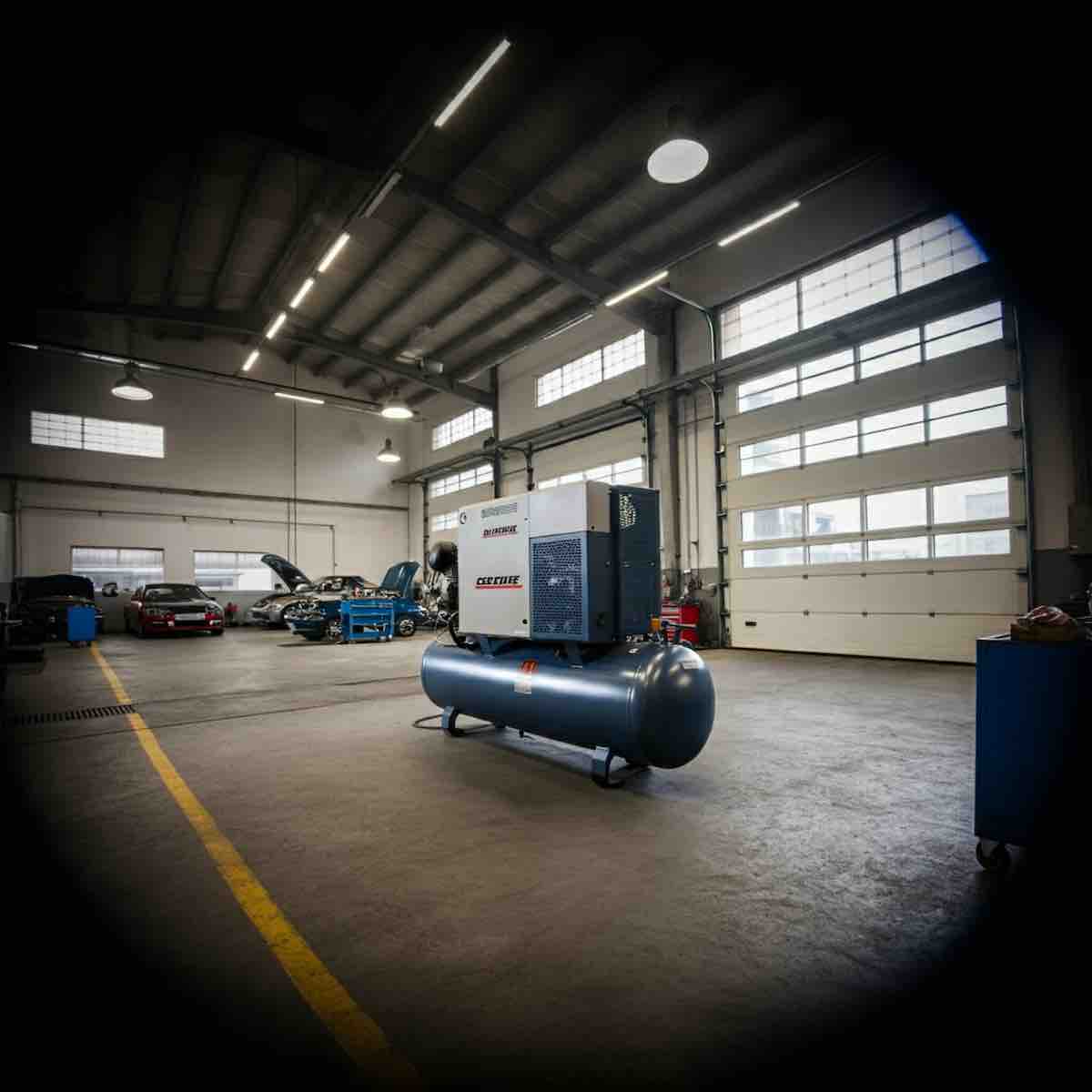How to Choose the Right Size Air Compressor for Your Pneumatic Tools
In the pneumatic tools power tools niche, having the right air compressor is crucial for optimal performance and efficiency. Whether you're a DIY enthusiast or a professional contractor, selecting the appropriate size air compressor can make all the difference in your work. This comprehensive guide will walk you through the process of choosing the perfect air compressor for your pneumatic tools, ensuring you make an informed decision that meets your specific needs.
Key Takeaway
The key takeaway from this article is that selecting the right size air compressor depends primarily on the air requirements of your pneumatic tools, not just the physical size of the compressor. Factors such as CFM (Cubic Feet per Minute), PSI (Pounds per Square Inch), tank size, and duty cycle are crucial in determining the most suitable air compressor for your needs.
Understanding Air Compressor Basics
Before diving into the selection process, it's essential to understand the fundamental aspects of air compressors:
CFM (Cubic Feet per Minute)
CFM is the most critical factor in choosing an air compressor. It measures the volume of air the compressor can deliver per minute. Your air compressor's CFM rating should match or exceed the requirements of your most demanding pneumatic tool.
PSI (Pounds per Square Inch)
PSI indicates the force at which the air is delivered. Most pneumatic tools require 90-120 PSI to operate effectively.
Tank Size
The air tank stores compressed air for use. Larger tanks can supply air for longer periods without the compressor motor running constantly.
Duty Cycle
This refers to the amount of time a compressor can run continuously before needing to cool down. A higher duty cycle means the compressor can run for longer periods without interruption.
Steps to Choose the Right Size Air Compressor
Follow these steps to determine the ideal air compressor size for your pneumatic tools:
- Identify Your Tools' Air Requirements
- List all the pneumatic tools you use or plan to use.
- Note the CFM and PSI requirements for each tool.
- Pay special attention to the tool with the highest CFM requirement.
- Calculate Total CFM Needed
- If you plan to use multiple tools simultaneously, add up their individual CFM requirements.
- Add 20-30% to this total to account for air leaks and future tool additions.
- Determine Required PSI
- Most pneumatic tools operate at 90-120 PSI.
- Choose a compressor that can deliver at least 20% more than your highest PSI requirement.
- Consider Tank Size
- For intermittent use, a smaller tank (2-6 gallons) may suffice.
- For continuous use or larger tools, consider tanks of 20 gallons or more.
- Evaluate Duty Cycle
- For occasional use, a 50% duty cycle may be adequate.
- For frequent or professional use, look for compressors with 75-100% duty cycles.
- Factor in Power Source
- Determine whether you need an electric or gas-powered compressor based on your work environment and mobility needs.
- Consider Portability
- If you need to move the compressor frequently, consider weight and wheel options.
Air Compressor Size Chart

To help you visualize the relationship between CFM, tool types, and compressor sizes, here's a handy chart:
| CFM Range | Suitable Tools | Recommended Compressor Size |
| 0-5 CFM | Brad nailers, staplers, small impact wrenches | 2-6 gallon |
| 5-10 CFM | Framing nailers, medium impact wrenches, small sanders | 8-20 gallon |
| 10-20 CFM | Large sanders, grinders, cut-off tools | 20-80 gallon |
| 20+ CFM | Sandblasters, large impact wrenches, multiple tools simultaneously | 80+ gallon |
Common Mistakes to Avoid
When selecting an air compressor, be wary of these common pitfalls:
- Focusing Only on Tank Size: A large tank doesn't necessarily mean high CFM output.
- Underestimating CFM Needs: Always choose a compressor with slightly more CFM than you think you'll need.
- Ignoring Duty Cycle: A low duty cycle can lead to frequent interruptions in work.
- Overlooking Power Requirements: Ensure your power source can handle the compressor's demands.
- Neglecting Maintenance Needs: Consider the long-term maintenance requirements of different compressor types.
Types of Air Compressors
Understanding the different types of air compressors can help you make a more informed decision:
- Reciprocating (Piston) Compressors
- Most common type
- Available in single-stage and two-stage versions
- Suitable for a wide range of applications
- Rotary Screw Compressors
- Ideal for continuous use
- Higher CFM output
- More expensive but more efficient for large-scale operations
- Centrifugal Compressors
- Used in industrial settings
- Very high CFM output
- Not typically used for individual pneumatic tools
Matching Compressors to Specific Tools
To give you a better idea of which compressor suits different tools, here's a breakdown:
- Small Air Tools (1-5 CFM)
- Brad nailers
- Staplers
- Airbrush guns
- Recommended: 2-6 gallon compressor
- Medium Air Tools (6-9 CFM)
- Framing nailers
- Spray guns
- Dual-action sanders
- Recommended: 20-30 gallon compressor
- Large Air Tools (10+ CFM)
- Impact wrenches
- Angle grinders
- Sandblasters
- Recommended: 60-80 gallon compressor
Factors Affecting Air Compressor Performance
Several factors can impact the performance of your air compressor:
- Altitude: Higher altitudes reduce compressor efficiency.
- Temperature: Extreme temperatures can affect compressor operation.
- Humidity: High humidity can lead to moisture in the air lines.
- Voltage Fluctuations: Inconsistent power supply can damage the compressor.
- Air Leaks: Even small leaks can significantly reduce effective CFM.
Maintenance Tips for Optimal Performance
To ensure your air compressor continues to perform at its best:
- Regularly check and change the oil (if applicable).
- Clean or replace air filters as recommended.
- Drain the air tank after each use to prevent moisture buildup.
- Inspect and tighten all fittings and connections periodically.
- Keep the compressor clean and free from dust and debris.
Future-Proofing Your Air Compressor Purchase
When selecting an air compressor, consider your future needs:
- Anticipate Growth: Choose a compressor that can handle additional tools you might acquire.
- Consider Versatility: Opt for a compressor that can handle a variety of tool types.
- Invest in Quality: A high-quality compressor will last longer and perform better over time.
- Look for Energy Efficiency: Energy-efficient models can save money in the long run.
Environmental Considerations
When choosing an air compressor, also consider its environmental impact:
- Noise Levels: Some compressors can be very loud. Consider noise-reducing models if working in sensitive areas.
- Energy Consumption: Look for energy-efficient models to reduce your carbon footprint.
- Oil-Free Options: These are more environmentally friendly and require less maintenance.
Cost Considerations
While it's tempting to opt for the cheapest option, consider the total cost of ownership:
- Initial Purchase Price: Higher quality compressors often have a higher upfront cost.
- Operating Costs: Energy-efficient models may cost more initially but save money over time.
- Maintenance Costs: Some compressors require more frequent maintenance, increasing long-term costs.
- Replacement Parts: Consider the availability and cost of replacement parts.
Frequently Asked Questions (FAQs)
Q: Can I use a smaller compressor if I only use my tools intermittently?
A: While it's possible to use a smaller compressor for intermittent use, it's generally better to choose a compressor that meets or exceeds your tools' CFM requirements. This ensures optimal performance and prevents overworking the compressor.
Q: How do I calculate the total CFM I need if I use multiple tools?
A: Add up the CFM requirements of all the tools you expect to use simultaneously. Then, add 20-30% to this total to account for air leaks and potential future tool additions.
Q: Is a larger tank always better?
A: Not necessarily. Tank size is important for air storage, but the compressor's CFM output is more critical. A large tank with low CFM output may not be suitable for continuous use of high-demand tools.
Q: How often should I drain my air compressor tank?
A: It's best to drain your air compressor tank after each use to prevent moisture buildup, which can lead to rust and contamination of your air supply.
Q: Should I choose an oil-lubricated or oil-free compressor?
A: Oil-lubricated compressors are generally more durable and suitable for heavy-duty use, while oil-free compressors are lower maintenance and better for environments where oil contamination must be avoided. Choose based on your specific needs and usage patterns.
Related Articles
To further expand your knowledge on air compressors and related topics, check out these informative articles:
- Understanding the Right Size of Air Compressor for Your Pneumatic Air Tools in 2024 This article provides an in-depth look at matching air compressor sizes to specific pneumatic tools, with a focus on the latest trends and technologies in 2024.
- The Ultimate Guide to Pneumatic Air Tools: Everything You Need to Know Dive deep into the world of pneumatic tools with this comprehensive guide, covering various types of air-powered tools and their applications.
- Top 10 Global Air Tools Brands: An Objective Comparison Explore the top air tool brands worldwide, helping you make informed decisions when purchasing pneumatic tools and compressors.
- Maintenance Tips: Ensuring the Longevity of Your Air Tools Learn essential maintenance practices to keep your air tools and compressors in top condition, maximizing their lifespan and performance.
- The Importance of Safety When Using Pneumatic Air Tools Safety is paramount when working with air-powered tools. This article covers crucial safety measures and best practices for using pneumatic tools and compressors.
Conclusion
Choosing the right size air compressor for your pneumatic tools is crucial for efficient and effective operation. By considering factors such as CFM, PSI, tank size, and duty cycle, you can select a compressor that meets your current needs and accommodates future growth. Remember to factor in maintenance, environmental considerations, and long-term costs when making your decision.
Call to Action
Ready to find the perfect air compressor for your pneumatic tools? Tend Industrial Supplies offers a wide range of high-quality air compressors to suit every need. Visittendsupplies.com to explore our selection and find the ideal compressor for your workshop or job site. Our knowledgeable team is always available to answer your questions and help you make the best choice for your air power needs.
For personalized assistance in selecting the right air compressor, don't hesitate to reach out to us at sales@tendsupplies.com. Let Tend Industrial Supplies power your pneumatic tools with the perfect air compressor today!







